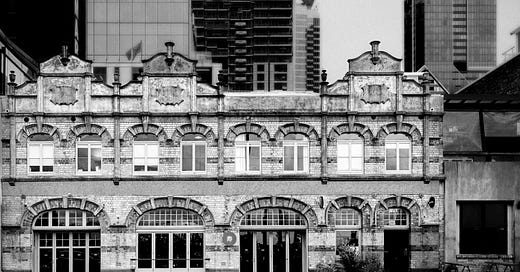Union Fish Company Building - Quay Street
I read an academic paper some years ago in which a musicologist attempted to answer the Dick Clark/American Bandstand question: Why are some songs intoxicatingly danceable - tunes that reflexively insist a seated person tap a foot, thump hand on table, or better yet hurl heedlessly to the dance floor?
In a word, the author concluded, syncopation. Establish a rhythmic pattern - the song’s beat - and then inset a counter accent, a stress on the weak beat, because we move to the ‘off beat’ . . . the song’s syncopation.
What makes the building in today’s entry ‘dance’ for me is not simply the stunning repetition of glorious half-moon arches above windows and doors nor merely the rhythmic repetition of cement keystone segments within each of the half-moon brick arches. Those architectural elements ground and define its design. They are the building’s melody, its foundational symmetry.
Against that expected pattern of visual symmetry, the building possesses a pair of asymmetries that insert a visual syncopation, a pattern of off beats, as it were, that infuse the building with a visual dynamism or movement. I refer here to the asymmetrical design of the far-right set of doors and the break in the placement of the cornice shields at the roof line - two on the left offset by only one on the right half of the cornice.
We careen off balance; we are set in motion, perhaps to dance.
There is a second curious observation: the building’s contemporary moniker - the Union Fish Company Building - obscures the structure’s historical significance as a commercial waterfront property within Auckland’s early automotive and marine engineering trades.
The Union Fish Company Building, built in the early years of the 20th century, was originally utilised for light industrial endeavours - first automotive importation, sales and service and then marine engineering. Only in more recent times has the building been re-purposed for use in the hospitality sector as a seafood restaurant - the origin of the fish company identifier - and today as the Japanese restaurant Ebisu.
Heritage New Zealand underscores the building’s notably placement in the commercial history of Auckland.
The Union Fish Company Building is a former office and workshop associated with the development of motorised transport in twentieth-century Auckland, especially cars and shipping. A two-storey brick structure of ornate design, the building was one of a number of light industrial structures located beside the main shipping wharves during the early 1900s. The structure was erected in 1905-1906 for the engineering firm of W. A. Ryan & Company, who imported motor cars from overseas. The company had been formed in 1894, when it was considered to be at the forefront of engineering technology in New Zealand. The firm maintained this reputation with the early importation of cars, which were luxury items requiring specialised mechanical support. The earliest such vehicles had been imported to Auckland in 1900, with nearby Queen Street being the earliest asphalted road in the city in 1902.
It was taken over by the United Repairing Company (URC) in 1912, when marine engineering became the major focus of activity. The URC was jointly owned by the Northern Steamship Company, whose headquarters were immediately next door to the workshop (see 'Northern Steamship Company Building'), and the Union Steamship Company, the largest private employer in the country. Demolition of the two-bay extension by 1962 can be linked to the decline in local shipping as the roading network improved. In the 1970s the original bays were converted into a bar and restaurant, latterly known as the 'Union Fish Company'. The building is an integral part of the Quay Street Historic Area, and survived plans for its demolition in the 1980s.
The Union Fish Company Building is significant as possibly the oldest surviving structure in Auckland linked with the importation of cars, heralding important changes in road transport. It is connected with technological innovation in New Zealand, particularly through its association with W. A. Ryan and Company. The building reflects the importance of engineering in the early twentieth century as the combustion engine took over from horses, sailing ships and steam. It is one of the few engineering workshops to survive in central Auckland that dates from the very early 1900s. The building is a valuable reminder of the once substantial working-class involvement in dockside life, and the diversity of activity beside the wharves. It is particularly important for its connections with the adjacent Northern Steamship Company Building, as together they provide a comparison of white- and blue-collar working environments. The building is significant for its association with New Zealand's role as a consumer of imported goods, and Auckland's function as a conduit for overseas trade. It has considerable value as one of a group of buildings along Quay Street that demonstrate Auckland's maritime and commercial past. 1
Heritage NZ - Union Fish Company Building
< https://www.heritage.org.nz/list-details/666/Union-Fish-Company-Building >




I like the clean repetition of form and lines in this one